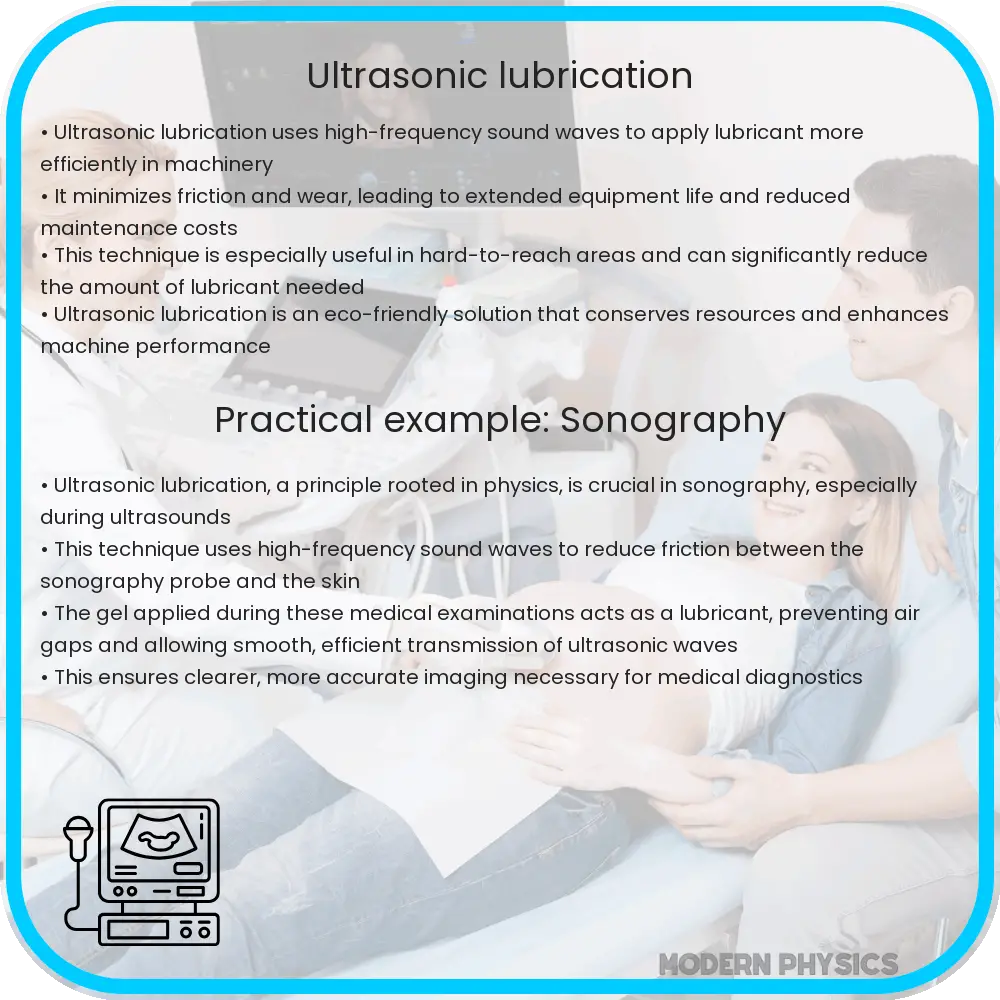Learn about ultrasonic lubrication, an advanced method using high-frequency sound waves for precise and efficient lubrication in mechanical engineering.

Introduction to Ultrasonic Lubrication
Ultrasonic lubrication is a cutting-edge technique that uses high-frequency sound waves to apply lubrication in a precise and efficient manner. This technology stands at the intersection of acoustics and mechanical engineering, offering a cleaner, quieter, and more precise alternative to traditional lubrication methods. In this article, we will explore the basics of ultrasonic lubrication, how it works, and its advantages in various applications.
What is Ultrasonic Lubrication?
Ultrasonic lubrication employs ultrasonic waves, typically within the frequency range of 20 kHz to 40 kHz, to disperse and apply lubricant to mechanical components. At these high frequencies, the sound waves are capable of agitating and thinning lubricants, enabling them to coat surfaces evenly and with great precision. This method is especially beneficial in situations where conventional lubrication techniques are either inefficient or impractical.
Key Principles of Ultrasonic Lubrication
The foundational principle behind ultrasonic lubrication is the use of vibration. Ultrasonic vibrations are generated by converting electrical energy into mechanical vibrations using a component known as the transducer. These vibrations have the unique capability to affect the viscosity of lubricants, making them thinner and easier to distribute over the surfaces of mechanical parts.
- Vibration Generation: A transducer converts high-frequency electrical signals into mechanical vibrations.
- Lubricant Dispersion: These vibrations reduce the viscosity of the lubricant, causing fine droplets to form and disperse evenly.
- Application: The ultrasonically-vibrated lubricant reaches difficult or sensitive areas without the need for physical contact.
Benefits of Ultrasonic Lubrication
Ultrasonic lubrication offers several benefits over traditional methods:
- Enhanced Precision: The ability to precisely control the amount and placement of lubricant reduces waste and ensures that lubrication is only applied where necessary.
- Reduced Lubricant Consumption: Thanks to its efficiency, ultrasonic lubrication often requires much less lubricant, which can lead to significant cost savings and environmental benefits.
- Improved Safety: By minimizing human interaction with moving parts during the lubrication process, ultrasonic lubrication enhances safety in manufacturing environments.
- Extended Equipment Life: Precise and effective lubrication extends the lifespan of machinery by reducing wear and tear and preventing over-lubrication, which can attract dirt and other contaminants.
These advantages make ultrasonic lubrication a favorable choice in industries such as automotive, aerospace, and manufacturing, where precision and efficiency are paramount.
Technological Components of Ultrasonic Lubrication
The main components responsible for the functionality of an ultrasonic lubrication system include:
- Ultrasonic Generator: This device is the power source that drives the transducer. It converts standard electrical power into high frequency electrical energy.
- Transducer: As mentioned, the transducer converts electrical energy into mechanical vibrations. It is the heart of the ultrasonic lubrication system.
- Lubrication Nozzle: Tailored to emit lubricant in a controlled and precise manner, this component directs the ultrasonically thinned lubricant onto specific areas of machinery.
Applications of Ultrasonic Lubrication
Ultrasonic lubrication finds applications in a myriad of industrial processes due to its precision and effectiveness. For example:
- Automotive Industry: In automotive production lines, ultrasonic lubrication is used to ensure precise oiling of engine components, which helps in reducing friction and extending the engine’s life.
- Textile Machinery: Ultrasonic lubrication is beneficial for textile machines that operate at high speeds and require continuous and precise lubrication to prevent overheating and wear.
- Food Production: Since ultrasonic lubrication allows for precise application without contact, it is ideal for food production lines where sanitation and avoidance of contamination are critical.
- Robotics: Robots with precise moving parts utilize ultrasonic lubrication to maintain smooth operation and prevent mechanical breakdowns.
Challenges and Considerations
While ultrasonic lubrication offers significant advantages, there are challenges and considerations that must be addressed to fully leverage its potential:
- Cost of Implementation: Initial setup costs for ultrasonic lubrication systems can be high due to the need for specialized equipment and technology.
- Technical Training: Operators must be properly trained to handle the sophisticated systems involved in ultrasonic lubrication to ensure optimal functionality and safety.
- Maintenance Needs: Regular maintenance is required to keep the ultrasonic systems functioning effectively, which includes periodic checks of the ultrasonic generator and transducer.
Conclusion
Ultrasonic lubrication represents a significant advancement in the field of industrial maintenance. By employing high-frequency sound waves, this technology offers a cleaner, more efficient, and precise method of applying lubricants to machinery. Not only does it enhance the performance and lifespan of equipment, but it also supports sustainability through reduced lubricant use and waste. Although it may come with higher initial costs and a learning curve, the benefits of ultrasonic lubrication in terms of cost savings and environmental impact make it a worthwhile investment for future-facing industries. As technology progresses, we can anticipate further improvements and wider adoption of ultrasonic lubrication techniques across various sectors.
By understanding the principles, components, and applications of ultrasonic lubrication, industries can make informed decisions about integrating this innovative solution into their operations. The potential to revolutionize maintenance practices makes ultrasonic lubrication a promising field in both engineering and technology.
